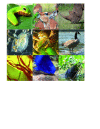Recent advances in plant-herbivore interactions
- PMID: 28232868
- PMCID: PMC5302155
- DOI: 10.12688/f1000research.10313.1
Recent advances in plant-herbivore interactions
Abstract
Plant-herbivore interactions shape community dynamics across marine, freshwater, and terrestrial habitats. From amphipods to elephants and from algae to trees, plant-herbivore relationships are the crucial link generating animal biomass (and human societies) from mere sunlight. These interactions are, thus, pivotal to understanding the ecology and evolution of virtually any ecosystem. Here, we briefly highlight recent advances in four areas of plant-herbivore interactions: (1) plant defense theory, (2) herbivore diversity and ecosystem function, (3) predation risk aversion and herbivory, and (4) how a changing climate impacts plant-herbivore interactions. Recent advances in plant defense theory, for example, highlight how plant life history and defense traits affect and are affected by multiple drivers, including enemy pressure, resource availability, and the local plant neighborhood, resulting in trait-mediated feedback loops linking trophic interactions with ecosystem nutrient dynamics. Similarly, although the positive effect of consumer diversity on ecosystem function has long been recognized, recent advances using DNA barcoding to elucidate diet, and Global Positioning System/remote sensing to determine habitat selection and impact, have shown that herbivore communities are probably even more functionally diverse than currently realized. Moreover, although most diversity-function studies continue to emphasize plant diversity, herbivore diversity may have even stronger impacts on ecosystem multifunctionality. Recent studies also highlight the role of risk in plant-herbivore interactions, and risk-driven trophic cascades have emerged as landscape-scale patterns in a variety of ecosystems. Perhaps not surprisingly, many plant-herbivore interactions are currently being altered by climate change, which affects plant growth rates and resource allocation, expression of chemical defenses, plant phenology, and herbivore metabolism and behavior. Finally, we conclude by noting that although the field is advancing rapidly, the world is changing even more rapidly, challenging our ability to manage these pivotal links in the food chain.
Keywords: climate impact; herbivore diversity; plant defense theory; plant-herbivore interactions.
Conflict of interest statement
Competing interests: The authors declare that they have no competing interests.No competing interests were disclosed.No competing interests were disclosed.
Figures



Similar articles
-
Herbivore regulation of plant abundance in aquatic ecosystems.Biol Rev Camb Philos Soc. 2017 May;92(2):1128-1141. doi: 10.1111/brv.12272. Epub 2016 Apr 8. Biol Rev Camb Philos Soc. 2017. PMID: 27062094 Review.
-
Functional trait diversity across trophic levels determines herbivore impact on plant community biomass.Ecol Lett. 2015 Dec;18(12):1346-55. doi: 10.1111/ele.12529. Epub 2015 Oct 6. Ecol Lett. 2015. PMID: 26439435
-
Host functional and phylogenetic composition rather than host diversity structure plant-herbivore networks.Mol Ecol. 2020 Jul;29(14):2747-2762. doi: 10.1111/mec.15518. Epub 2020 Jul 4. Mol Ecol. 2020. PMID: 32564434
-
Shifting species interactions in terrestrial dryland ecosystems under altered water availability and climate change.Biol Rev Camb Philos Soc. 2012 Aug;87(3):563-82. doi: 10.1111/j.1469-185X.2011.00209.x. Epub 2011 Nov 17. Biol Rev Camb Philos Soc. 2012. PMID: 22098619 Review.
-
Phylogenetic diversity and co-evolutionary signals among trophic levels change across a habitat edge.J Anim Ecol. 2015 Mar;84(2):364-72. doi: 10.1111/1365-2656.12296. Epub 2014 Oct 24. J Anim Ecol. 2015. PMID: 25279836
Cited by
-
Defence emergence during early ontogeny reveals important differences between spines, thorns and prickles.Ann Bot. 2020 Jan 6;124(7):iii-iv. doi: 10.1093/aob/mcz189. Ann Bot. 2020. PMID: 31904092 Free PMC article. No abstract available.
-
Species-specific responses drive browsing impacts on physiological and functional traits in Quercus agrifolia and Umbellularia californica.PLoS One. 2024 Jul 24;19(7):e0287160. doi: 10.1371/journal.pone.0287160. eCollection 2024. PLoS One. 2024. PMID: 39047008 Free PMC article.
-
Seagrass Tolerance to Simulated Herbivory Along a Latitudinal Gradient: Predicting the Potential Effects of Tropicalisation.Ecol Evol. 2024 Nov 17;14(11):e70561. doi: 10.1002/ece3.70561. eCollection 2024 Nov. Ecol Evol. 2024. PMID: 39559467 Free PMC article.
-
Land use is a stronger determinant of ecological network complexity than the number of trophic levels.PLoS One. 2024 Feb 9;19(2):e0295377. doi: 10.1371/journal.pone.0295377. eCollection 2024. PLoS One. 2024. PMID: 38335167 Free PMC article.
-
Natural Products Diversity in Plant-Insect Interaction between Tithonia diversifolia (Asteraceae) and Chlosyne lacinia (Nymphalidae).Molecules. 2019 Aug 28;24(17):3118. doi: 10.3390/molecules24173118. Molecules. 2019. PMID: 31466223 Free PMC article.
References
-
- Ehrlich PR, Raven PH: Butterflies and Plants: A Study in Coevolution. Evolution. 1964;18(4):586–608. 10.2307/2406212 - DOI
-
- Johnson MT, Campbell SA, Barrett SC: Evolutionary Interactions Between Plant Reproduction and Defense Against Herbivores. Annu Rev Ecol Evol Syst. 2015;46(1):191–213. 10.1146/annurev-ecolsys-112414-054215 - DOI
-
- Hay ME, Fenical W: Marine Plant-Herbivore Interactions: The Ecology of Chemical Defense. Annu Rev Ecol Syst. 1988;19(1):111–45. 10.1146/annurev.es.19.110188.000551 - DOI
Publication types
LinkOut - more resources
Full Text Sources
Other Literature Sources

